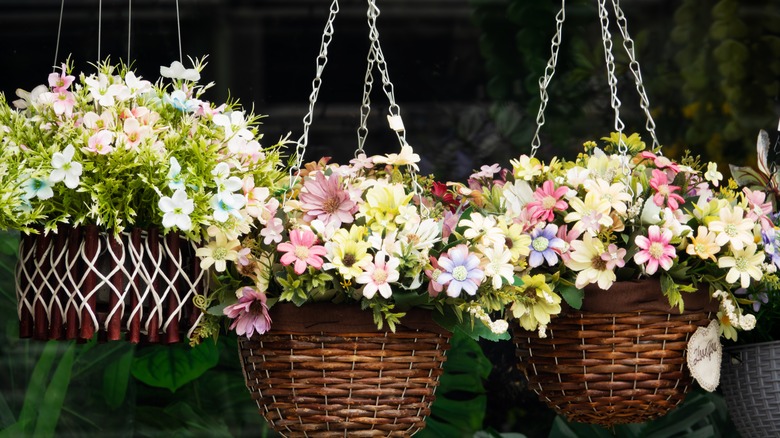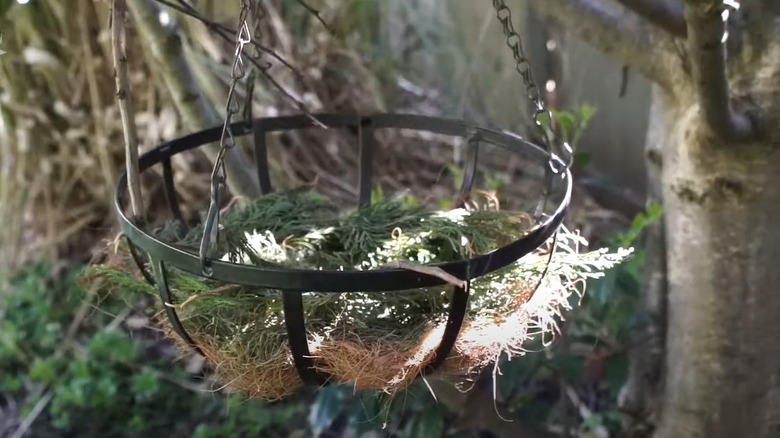The Easy Way Bird Lovers Should Be Reusing Old Hanging Baskets In Their Yard
Ah, those dusty, spider web-garnished baskets chilling in the corners of your garage or shed, or maybe swaying in your patio? You've probably seen them every day, and honestly, they've lost their sparkle. However, they're not quite ready for the trash. Or perhaps, you've found yourself with empty hanging baskets post-repotting, unsure of their fate. Here's a creative twist for those with a soft spot for both plants and birds: fashioning floating bird nests out of these old hanging baskets. Just clear them, then pop in nest-friendly materials, and voila, you've got your feathery friends' new homes. By doing so, you're giving those baskets a second shot at glory while also attracting birds to your garden.
Repurposing old baskets into bird nests is a boon for your garden's biodiversity, too. Welcome those avian friends in, and they'll thank you by keeping the tunes coming, pollinating your plants, and keeping harmful bugs (think mealybugs, beetles, and aphids) in check. Pretty neat payoff from just sprucing up a bunch of forgotten baskets, right? Plus, It's a breeze to pull off — you'll be done in less than 20 minutes. But here's the thing: this isn't just about being resourceful or patting yourself on the back for being eco-smart. The real trick is ensuring the newly minted bird nests are nestled in serene spots, away from prying predators. After all, the goal is to have these DIY nests bustling with birdlife, not just as decorative pieces.
How to repurpose an old hanging baskets into a bird nest
This quest to build a floating bird nest kicks off with a good cleanup. Got a solid hanging basket? Remove any old dirt, wilted plants, or moss clinging on from its past life. Then, give it a good wash; a splash of water and a dab of mild soap should do the trick to get rid of any nasties. If it's metal fry hanging baskets, you may only need to chuck the old liner.
Now, let's get to the cozy part. Line the bottom of the baskets with some liner to form a solid foundation. Got some coir? Perfect! If not, a bunch of twigs or small sticks will work just fine. For the best nest materials, go natural with straw, grass clippings, feathers, and dry leaves. Pack them down well so they don't blow away, but keep the layers fluffy enough for the birds to do a bit of DIY too. You could even adorn the basket's edge with some twigs or pine needles for that rustic touch. Next step: finding the perfect spot for your DIY nests. You want somewhere protected from the elements but still cozy and private. A shrub, wall, or fence is ideal. And height matters — too low and you might as well welcome predators like cats. In addition, ensure the nest sways only gently in the wind, nothing too wild. A little movement is natural and fine, but too much could deter birds.
A few extras to consider for this DIY
Speaking of nesting materials, ditch the dryer lint —it's a chemical cocktail and falls apart when wet. Avoid human hair and knitting wool, too. They seem cozy but can become unintentional traps for your avian friends. And how about taking this DIY a notch higher with a stroke of your green thumb? If your metal fry basket is large enough, introduce some trailing vines and tall grass around its edges, tapping into birds' natural inclination to keep their nests camouflaged from predators. The trick? Pop a saucer in the middle, surround it with potting soil, slot in your plants, whisk the saucer away, and fill the newfound space with nesting materials.
To create a mini bird neighborhood, add a DIY bird feeder to the mix. Place it a considerable distance from the nest, though. You're aiming for neighborhood vibes, not a bustling bird city, after all. You also want to sprinkle a handful of dry, crushed eggshells into your feeder to give the birds a calcium boost for their egg-making business. However, keep your curiosity in check. Peeking into the nest too often can spook the residents — a weekly check-up is plenty. And once you're certain the nest has been abandoned, that's your cue to clear out the old material, clean the hanging basket, and prime it for the next round of feathery inhabitants. Most songbirds take about two to three weeks post-hatching before they venture out on their own.

